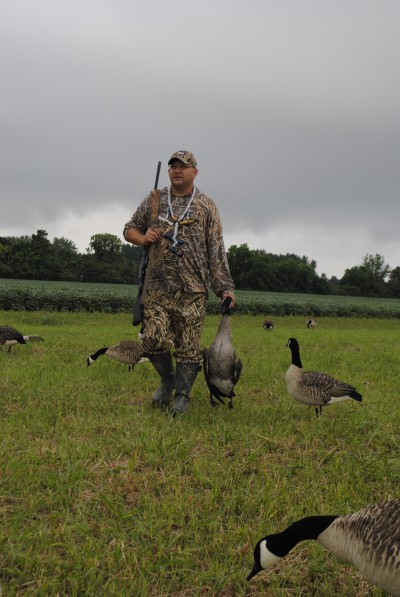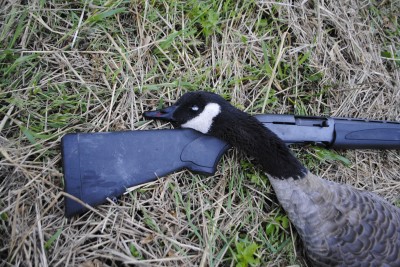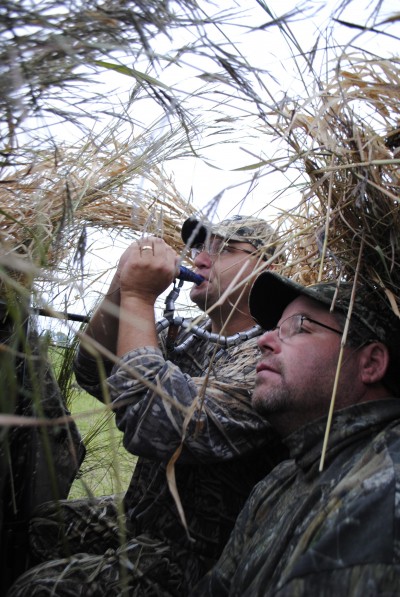Michigan’s Waterfowl Opener Offers a Gaggle of Results
Bob Gwizdz 09.03.13


The first group of Canada geese, six of them, arrived just past the beginning of legal shooting time. Winging in from the south of us, they barely gave our decoys (standing in a wheat field bordered by soybeans) a look. They were out of there before they even approached shooting range.
Uh-oh.
Joe Robison, a veteran waterfowl hunter and the ramrod on this opening-morning hunt, says the first flight of the day often tells you how things are going to go. This was not a good sign.
A short while later, a single came in from the same direction, but this one hooked and headed straight to us. Robison called for me to take the shot, but being vertically challenged and sitting on a low stool in the blind, I hadn’t even seen it. I said so.
“Just shoot it,” he said.
I stood up and did. Less than 30 minutes into the 2013 waterfowl season, we were in the plus column. That’s better.
But it turned out to be the exception, not the rule. A half-hour later, a high-flying flight of geese approached from the distance. They dropped altitude as they arrived, but never locked their wings. Robison announced that we were going to have to take them as they passed and when they got as close as they were going to—shootable, but not at optimum range—Robison called “Take ‘em.”
I stood up, picked out a bird, and fired, saw that I’d rocked it but hadn’t hit it hard enough, then squeezed off two more rounds, to no discernible effect. Everyone else shot, too. One goose dropped stone dead in the field and another sailed well into the beans.
“What kind of shooting was that?” Robison asked.
I had no excuse. Neither did Ronnie Levitan, a veteran charter boat skipper who was seated next to me. He’d had the same experience as I did, he said; he’d rocked one, and then missed.
Mike Kreger, on the far side of the blind, didn’t comment. He just said he’s had a fairly good mark on the bird in the beans and he went to try to find it. He was unsuccessful. Robison just shook his head.

An hour passed. We heard some shooting in the marsh to the north behind us. Robison cringed; that’s where the geese that had been using the field had been coming from, he said.
“That’s opening day of goose hunting,” Robison said. “Guys are hunting everywhere. You never know what’s going to happen.”
Finally, a trio of birds came from the south and headed toward us, then smelled a rat. Robison called the shot. I took aim at the nearest bird—heading directly away from us—and fired. The bird fell, but the other two kept going. I suspect we’d all fired at the same bird.
“It’s a weird day,” said Robison, a wildlife biologist with the Department of Natural Resources with whom I’ve been waterfowl hunting for about two decades. “They’ve been in here every day for a week. Monday or Tuesday there were 200 birds in here. Yesterday there were 80 to 90.
“I don’t know whether those guys hunting the marsh pushed them out of there or what, but they didn’t fly.”
We hung around another hour, chewing the fat. Robison’s smartphone was beeping like a robot on a cheap sci-fi flick as guys texted in their results from across the state.
“Shawn Stahl [a top-notch goose hunter we know from the west side of the state] didn’t see a bird in a field he’d scouted all week,” Robison reported. “A buddy of mine in Jackson killed three. Another buddy in Jackson killed zero. A buddy of mine in Brighton killed a limit—15. Another buddy in Hillsdale killed 21.”
And so it goes. Some guys got ‘em. Some guys didn’t.

I’d had high hopes. We had a nice spread of about 50 flocked, full-bodied decoys in front of us, arranged in a T-pattern—a thick line perpendicular to our blind with a couple of pods on both sides of the line. That would give the birds a couple of nice openings to come into. And we were well hidden in a Zink A-Frame blind that assembled quickly and provided a fair level of comfort.
“You can shoot out of it better than from a ground blind,” Robison said. “Some guys have a hard time shooting from ground blinds, especially older people like you and Ronnie.” (Thanks, Joe.)
Despite our slowish start to the season, Robison expects goose hunting—which is often spectacular—to be good this fall, though perhaps a little below average.
“The goose population is down a little bit because of nesting conditions,” he said. “A lot of nests were flooded out this spring and if they did re-nest, the broods were smaller. That’s typical. We noticed it when we were banding. At all of our banding locations—seven or eight of them—our numbers were down compared to the last two years.
“But the populations are still above management goals, so there are still a lot of geese around. There’s a lot of season to go.”
Indeed, Michigan goose hunters have well more than 100 days this year, running from now until mid-February. You’ve got to figure that at some point, they’re going to cooperate.
For more information on Michigan hunting go to michigan.org. Click here to purchase a Michigan hunting license online.

